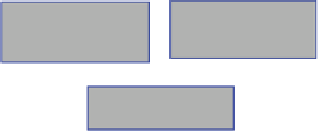Biology Reference
In-Depth Information
Enzyme free DNA
based circuit
created
Synthetic yeast
chromosome arms
created
3D origami
created
Development of
DNA/RNA hybrid
nanomachines
Synthetic RNA only
nanodevice
created
Development of DNA
nanomachines
First chemically
synthesized
bacterial genome
First biological
computer created
out of DNA
2000
2001
2002
2003
2004
2005
2006
2007
2008
2009
2010
2011
2012
DNA nanobots
targeting cancer
cells
Development of DNA
logic gates
DNA Kirigami
(folding and cutting
DNA) created
Genetic alphabet
expanded
DNA origami
developed
Amplifying gates
created to enable
production of large
scale circuits
Reversible DNA
circuits created
FIGURE 15.2A
Significant discoveries in nucleic-acid-based synthetic biology: Breakthrough discoveries in DNA and RNA synthetic biology that propelled the field forward
are shown along a timeline.
AND Gate
A
C
B
Input A
281
Input B
Output strand C
FIGURE 15.2B
DNA logic gate: An example of a DNA logic gate: the AND gate, is illustrated. The gate is composed of three strands (A, B,
and C) along with Toeholds indicated in color. Two input strands (strand A and strand B) are required to displace the A and
B strands resulting in the output C strand. The released output strand can be further used as input for a downstream gate or
may fluoresce upon release.
scalable, and rely on Watson-Crick base-pairing between strands. Both DNA and RNA
have been used.
DNA logic circuits initiated the field
35
and have remained a prominent fixture of
development. Indeed, by modulating DNA species (i.e. bit information), concentration, and
quantity, researchers have constructed a variety of enzyme-free in vitro DNA-based logic
gates capable of Boolean logic functions (AND, OR, NOT). In one exemplary report, Seelig
et al. described the construction of a circuit composed of 11 gates.
36
An example of a DNA
logic gate is illustrated in
Figure 15.2B
.




















































